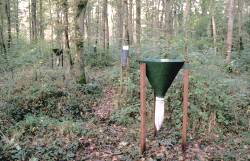 Tree cover will inevitably influence a sites microclimate and the quantities and chemistry of any wet deposition entering the ecosystem. Trees are efficient at removing or intercepting particles, water droplets and gaseous compounds from the atmosphere. The local atmospheric chemistry being intercepted and to a lesser extent the species of tree can strongly influence the chemical composition of the water that reaches the ground. This property, along with other aspects of a wooded microclimate are outlined below.
Tree cover will inevitably influence a sites microclimate and the quantities and chemistry of any wet deposition entering the ecosystem. Trees are efficient at removing or intercepting particles, water droplets and gaseous compounds from the atmosphere. The local atmospheric chemistry being intercepted and to a lesser extent the species of tree can strongly influence the chemical composition of the water that reaches the ground. This property, along with other aspects of a wooded microclimate are outlined below.
Precipitation chemistry
The pH of the water passing through the canopy (throughfall (TF)) compared to the precipitation outside the woodland can be either more or less acidic. How the TF will affect above-ground archaeological remains will not only depend upon the TF chemistry, but also the composition of the feature. Some studies have shown that sheltering standing stones from water could reduce chemical erosion.
Lichens
TF may have an indirect influence on weathering rates of standing or carved stones through its effects on lichen communities. Lichens can grow on and into rock and utilise surface minerals as a substrate. Many species are environmentally sensitive and only occur in limited habitats. Thus, lichen populations have been altered by increased pollution or other changes in their environment. As the chemistry of TF has a higher ion concentration than rainwater, it may influence the species of lichen found and possibly change the source of substrate used from the stone to the TF thereby decreasing weathering rates.
Frost damage
Freeze-thaw of rock occurs as water percolates into small fissures on the surface. When it freezes, the ice expands and the fissures widen further. As temperature fluctuations are less within woodland, any freeze-thaw should be reduced. The wet deposition in a woodland environment TF has a higher ion content than rain water, and this further decreases its freezing point. Thus a wooded environment may reduce the occurrence of frost damage to standing or carved stones.
Rain
This is a significant cause of erosion. Several studies have shown its ability to dislodge soil particles. Rainfall induced erosion on a slope is most effective on bare soil. Surface runoff begins when rainfall exceeds plant uptake and soil infiltration. Under certain conditions, this can lead to significant soil displacement and archaeological earthworks can be at risk of erosion. However, a woodland canopy generally reduces the quantity of rainfall that reaches the soil. Rain droplets passing through the canopy may increase in size following accumulation on the leaf surfaces, however this combined with the forest leaf litter reduces their kinetic energy before they reach the soil.
Airborne soil movement
Wind can directly cause the translocation of soil particles. Tree cover decreases the efficiency of wind erosion by reducing wind speed and filtering out any wind borne soil particles. Such protection has been used in agriculture with the establishment of tree cover in the form of shelterbelts.
Susceptibility of a site to rain or wind-induced erosion
The susceptibility of a site to either rain or wind-induced erosion is dependent upon many factors such as soil type, slope aspect, angle and length, vegetation cover and geography. Tree removal or forest operations on an archaeological earthwork or site have the potential to result in some short-term bare soil exposure. However, with adequate soil protection, this risk can be reduced.
